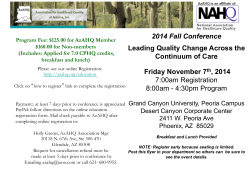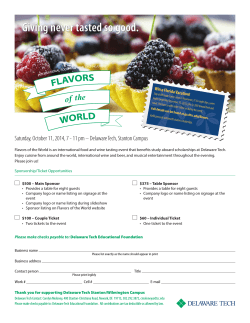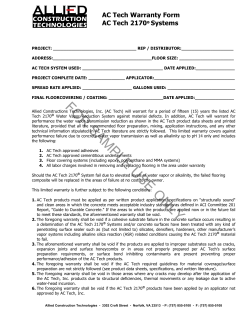
Chapter 7 Reading ASNAT Assessing Student’s Needs for
ASNAT Assessing Student’s Needs for Assistive Technology Chapter 7 Reading Wisconsin Assistive Technology Initiative www.wati.org This PowerPoint was made possible by funding from IDEA grant number 9906-23. Its content may be reprinted in whole or in part, with credit given to the Wisconsin Assistive Technology Initiative (WATI) and the Wisconsin Department of Public Instruction (DPI) acknowledged. Reproduction of this PowerPoint in whole or in part for resale is not permitted. Objectives • Participants will understand the SETT process as it relates to identifying appropriate AT for students with difficulty reading and or understanding text. • Participants will have basic knowledge of the AT continuum for Reading as identified in the ASNAT 2009 Reading Chapter. • Participants will be able to access resources and tools for trial with students who need AT reading supports. Introduction • 2009 ASNAT revision (Assessing Students’ Need for Assistive Technology) • Uses the SETT framework for AT assessments Student Environment Tasks Tools – Framework developed by Joy Zabala 2002 • http://sweb.uky.edu/~jszaba0/SETTUPDATE.PDF – Implementation Plan & Follow-up added by WATI • Revised version has added Sensory Considerations Using the SETT framework • Traditional” SETT – The Student • • • • Identify the functional area(s) of concern? Special needs (related to area of concern) Current abilities (related to area of concern) What does the student need to communicate that is difficult or impossible to do independently at this time? Using the SETT framework • The Environment(s) – Arrangement (instructional, physical) – Support (available to both the student and the staff) – Materials and Equipment (commonly used by others in the environments) – Access Issues (technological, physical, instructional) – Attitudes and Expectations (staff, family, others) Using the SETT framework • The Tasks – What SPECIFIC tasks occur in the student’s natural environments that enable progress toward mastery of IEP goals and objectives? – What SPECIFIC tasks are required for active involvement in identified environments? (related to communication, instruction, participation, productivity, environmental control) Using the SETT framework • The Tools – Tools include devices, services and strategies… everything that is needed to help the student succeed. – Describe what a useful system of assistive technology devices and services for the student would be like. – Brainstorm Tools that could be included in a system that addresses student needs. – Select the most promising Tools for trials in the natural environments. – Plan the specifics of the trial (expected changes, when/how tools will be used, cues, etc.) – Collect data on effectiveness. (Zabala 2002) Using the SETT process Decision Making Guide WATI’s version of the SETT Framework For Reading Guide will be Different for every area of AT assessment Using the Student Information Guide in the SETT Process • The Guide is intended to help the team discuss key issues when assessing the need for AT for a specific student. • It helps teams consider whole child & environment & not “jump” to a device! • It is a group (sped, reg. ed, support staff, admin., parent, student) process in which everyone contributes. • Important to write on a large format so that everyone can see, edit, remember (shared group memory), stay focused, and be informed! • Team members take roles of: Facilitator, Recorder, Time Keeper Assistive Technology for Background Background • LEAs must provide accessible core instructional text for students with print disabilities: – Students must meet NIMAS criteria as having an identified print disability as documented in their IEP. • Blind or visually impaired • Physical limitations • Organic Dysfunction For specific information about Wisconsin NIMAS standards, procedures or criteria, go to http://dpi.wi.gov/sped/vision.html Assistive Technology for The Student Student List the functional areas of concern What are the student’s special needs related to the area of concern. What are the student’s abilities? What motivates the student? Other questions you might ask? Assistive Technology for The Environment Environmental Considerations What specific environmental considerations need to be addressed? Obstacles? Supports? Attitudes of others? What are other the environments that need to be taken into account? Sensory Considerations (new) New section as a subset of Student & Environment •Does this student have sensory deficits or sensitivities that will impact his/her ability to read or process written text? •Do the learning environment(s) impact the sensory issues of the student? Sensory Considerations STUDENT • Visual clutter on page • Auditory sensitivity to computer read text • Organization of work space • • • • ENVIRONMENT Background noise Visual distractions Lighting (full spectrum vs. flourescent) Physical space Assistive Technology for The Task Tasks to Consider • What does the student need to do to achieve educational goals from their IEP and be an active participant in their environment? • What are other students doing in the same environments? Narrowing the Focus • As a team, identify by circling or other means those few tasks the student needs to do that will have the most impact. Solution Generation: Tools/Strategies As a team, brainstorm and write on chart paper any assistive technologies &/or strategies you think will assist the student in successfully completing those tasks you identified. – Brainstorm possible AT – Don’t evaluate (yet)! – Remember to include AT that the student already uses – Use all resources including people Assistive Technology for The Tools AT Continuum • Follow the progression of low tech, through mid tech to high tech when selecting assistive technology tools Assistive Technology: past and present • Part of the Student’s past & current environment – List any tools that the student is currently using or has used in the past to assist with reading tasks. • Success rate? • If “abandoned”, why? Assistive Technology for Low Tech Tools AT Continuum Low Tech • Standard text – Use reading strategies & tools – Color • Highlighters • Highlighting tape • Colored overlays or reading strips • Books adapted for access – Page fluffers – Flip Page Turner - www.ablenetinc.com – BookWorm - www.ablenetinc.com AT Continuum Low Tech • Books adapted for access cont. – Visual Modifications • Enlargement • Increased spacing • Hand-held or bar magnifiers • Low Tech Modifications to text • Modify vocabulary (use Wite-0ut® to replace wording) • Use visual cues for trouble words, where to start reading, etc. • Language Master to read trouble words Assistive Technology for Mid Tech Tools AT Continuum Mid Tech • Handheld device to read individual words – Talking Dictionary – www.franklin.com – Reading Pens • Wizcom – www.wizcom.com • Iris – www.irislink.com AT Continuum Mid Tech •Use of Pictures/Symbols with Text -Software oBoardmaker v. 6 – www.mayer-johnson.com oClicker - www.cricksoft.com/us/default.asp oIntelliTools Classroom Suite - www.intellitools.com oNews 2 You - www.news-2-you.com oPicture It - www.slatersoftware.com oWriting With Symbols or Symwriter - www.mayerjohnson.com Silver-Pascuilla, H., Ruedel, K. & Mistrett, S. reported that seeing words illustrated was an effective strategy for emerging readers (2004). AT Continuum Mid Tech Electronic Text • Commercial e-books – – – – – Balanced Literacy – www.intellitools.com Leap Frog – www.leapfrog.com Planet Wobble – www.planetwobble.com Start to Finish series – www.donjohnston.com Thinking Reader – www.tomsnyder.com Project LITT: Literacy Instruction through Technology conducted a three year study of the effectiveness of hypermedia based children's literature in improving reading skills of students with learning disabilities http://edtechfm.sdsu.edu/SPED/ProjectLITT/LITTinfo.html AT Continuum Mid Tech Electronic Text • E-book sites for downloading (free!) – Bookshare – www.bookshare.org (student must qualify with a print disability) – Project Gutenberg - http://www.promo.net/pg/ – Starfall - http://www.starfall.com/ – Teacher Tap - (comprehesnive resource of e-books) http://eduscapes.com/tap/topic93.htm – UDL editions - http://udleditions.cast.org/ AT Continuum Mid Tech Electronic Text • E-book sites for downloading (subscription) – – – – One More Story - http://www.onemorestory.com/ Reading A-Z - http://www.readinga-z.com Tumblebooks - http://www.tumblebooks.com/ Listing of electronic books http://atto.buffalo.edu/registered/ATBasics/Curri culum/Reading/electronicbooks.php AT Continuum Mid Tech Electronic Text • Modified E-book sites – Accessible Book Collection http://accessiblebookcollection.wikis paces.com/ – Classic Bookshelf www.classicbookshelf.com – Tarheel Reader http://tarheelreader.org/ Classic Bookshelf AT Continuum Mid Tech Electronic Audio Text Text doesn’t always have to be viewed. Secondary level students with mild disabilities performed higher in content assessments when they used audio texts compared to standard print based text (Boyle, Rosenberg, Connelly, Gallin Washburn, Brinckerhoff, & Banerjee, 2003). iTunes – www.itunes.com Recordings for the Blind & Dyslexic http://www.rfbd.org/ PlayAway – www.playaway.com Players include: iPod, MP3 player, FP3 player (not compatible with MP3) – Convert text to audio using a text conversion program (SpeakAloud, Text-to-Audio, etc.) – – – – AT Continuum Mid Tech Handheld Electronic Text Readers • Amazon Kindle – www.amazon.com • Classmate Reader – www.humanware.com • Victor Reader Stream – www.humanware.com Kindle DX Classmate Reader AT Continuum Mid Tech Modifying Electronic Text – Use word processor to modify • Font • Size • Spacing between words, l e t t e r s , lines • Margins (increase margins to show fewer words per line) • Color - text & background • Readability – use autosummarize features to cognitively reformat text AT Continuum Mid Tech Create You Own Modified text/books – CAST UDL Bookbuilder http://bookbuilder.cast.org/ – Clicker - www.cricksoft.com/us/default.asp – Cueline ED – www.onionmountaintech.com – eStoryMaker http://www.oatsoft.org/Software/estorymaker – IntelliTools Classroom Suite - www.intellitools.com – My Own Bookshelf – www.softtouch.com – PowerPoint – part of Microsoft Office AT Continuum Mid Tech Modifying Text for Sensory Impairments – Hearing Impairments • Sign Language Avatars – www.vcom3d.com – Visual Impairments • Use accessibility features in computer control panel • Enlarge text on web browser http://www.saltmeadow.com/large.html • Consult with teacher of Visually Impaired Assistive Technology for High Tech Tools AT Continuum High Tech Text Readers Research shows: – TTS (Text to Speech) helps special education students improve comprehension, fluency, and accuracy and enhances concentration – Being able to immediately decode a word by hearing it spoken within the context of a passage helps students build word recognition and vocabulary without disturbing the flow of comprehension – These technologies provide a supportive reading environment and increase a student’s ability to read interesting and appropriate grade-level materials by minimizing the need for decoding skills and maximizing the student’s ability to comprehend (Silver-Pascuilla, et.al, 2004) AT Continuum High Tech • Text Readers as part of the computer OS – Mac OS • Spoken User Interface (control panel) • Text Edit (application included with Macs) – Windows OS • Narrator • Windows XP working with Word 2003 can use built-in TTS in Word AT Continuum High Tech Free downloadable Text Readers • Acrobat Reader – (built into Adobe Reader) – www.adobe.com/AcrobatReader • Balabolka – www.cross-plus-a.com/balabolka.htm • Natural Reader - http://naturalreaders.com • ReadPlease - http://www.readplease.com • Spoken Text - http://www.spokentext.net/ • WordTalk - www.wordtalk.org.uk AT Continuum High Tech • Web based Text readers – CLiCk, Speak (works with Firefox browser) – http://clickspeak.clcworld.net – Read the Words - www.readthewords.com – WebAnywhere http://webanywhere.cs.washington.edu/wa.php Read the Words AT Continuum High Tech • Commercial Text Readers – AbleReader – www.ablereader.com – Read: OutLoud – www.donjohnston.com – TextAloud – www.textaloud.com AT Continuum High Tech Iowa Study research supporting text readers: • Students were able to access twice as much material using the text reader as printed text (160 wpm vs 79 wpm) • Student’s comprehension increased using text reader even though difficulty of text increased compared to comprehension with printed text • Improvements and attitudes increased over time (better the 2nd year of the study) http://store.cambiumlearning.com/Kurzweil/files/Iowa_Text_Rea der_Study_Report.pdf AT Continuum High Tech Scanning Software with OCR and Text Reader • • • • • • ClaroRead – www.clarosoftware.com Kurzweil – www.kurzweiledu.com Premier Assistive Technology – www.readingmadeez.com Read and Write Gold – www.readwritegold.com Scan N Talk – www.colligo.us/Scan_N_Talk.php WYNN – www.freedomscientific.com Many of those listed above have a “mobile” USB flashdrive version available. AT Continuum High Tech Text Reader with Study Skill Supports “There is good evidence that struggling readers can improve reading comprehension skills by learning the strategies of proficient readers and putting them into practice” (Don Johnston, Inc., 2005). Don Johnston, Incorporated. (2005). The scientific-based research underlying Read:OutLoud™ & Solo™. Retrieved March 3, 2007, from http://www.donjohnston.com/research/readoutloud_index.html AT Continuum High Tech Text Reader with Study Skill Supports Varying levels of study skill supports built into: – ClaroRead – Kurzweil Read: OutLoud – Premier Assistive Technology – Read and Write Gold – Read: OutLoud – WYNN Search for features of reading supports using Tech Matrix - www.techmatrix.org Solution Selection: Tools & Strategies • Review the list of potential tools – Now is the time to evaluate for a match with: • Student (abilities, difficulties, likes/dislikes) • Environment (supports, obstacles) • Tasks (what 1-2 things do you want the student to do?) – Prioritize selections Implementation Plan • Very Important! This is often where it breaks down! – Write down on the group chart (for top priorities) • • • • Who is going to do… (get specific) What (ditto) When (do I need to say it again?) For how long? – Write down your expectations (objectives) so you know if the AT is working or not! – Give everyone a job Follow-up Plan • Before the meeting is over, plan the follow-up – For accountability – We are all busy, so plan it now! – Bring list from original meeting so group can review who, what, when, & expectations Sample IEP objectives • Kori will use a hand-held device to find the definitions of 5 unfamiliar words in a grade level passage. • After listening to a grade level story presented on and read by the computer, Jenny will be able to tell what happened at the beginning and ending of the story with 80% accuracy. • Using text reading software with study skills supports, Mark will highlight grade level passages that answer “Who, What, When and Where” questions with 80% accuracy. Conclusion • It’s not about the technology/device- it’s about matching the Student, the Environment and the Task with the best Tool • Finally some research about using technology……. – …using technology for compensatory intervention actually also provides remedial benefits (Silver-Pacuilla, H., Ruedel K. & Mistrett, S. p. 8). Tools Resources • CAST (Center for Applied Special Technology) A resource for NIMAS, NIMAC, Universal Design for Learning, and a support for school teachers and administrators through professional development, consultation, publications, and online resources. http://www.cast.org/index.html • CITEd Home of the TechMatrix 2.0, an initiative of the National Center for Technology Innovation and the Center for Implementing Technology in Education. Create a customized matrix by subject and/or learning supports. http://www.techmatrix.org/ Tools Resources • Florida Center for Reading Research This research site describes types of reading programs (core, supplemental, tech based, remedial, implemented by tutor); reading components; empirical research, and misc. notes. Each of the reviewed programs includes a pdf narrative. http://www.fcrr.org/FCRRReports/reportslist.htm • Never Too Late: Approaches to Reading Instruction for Secondary Students with Disabilities Part of OSEP’s IDEAs that Work documents for Instructional Practices. Gives two different models for helping older students with reading disabilities increase their skills. Document can be downloaded & printed http://www.osepideasthatwork.org/toolkit/InstPract_never_to_lat e.asp Tools Resources • Project LITT: Literacy Instruction through Technology Focuses on the role that technology can play in improving the reading skills of students with learning disabilities, specifically “talking books”. http://www.eric.ed.gov/ERICDocs/data/ericdocs2sql/content_stor age_01/0000019b/80/16/13/66.pdf • The Industry Profile on Education Technology: Learning Disabilities Technologies and Markets A comprehensive profile of educational and assistive technology, products for students with learning disabilities in reading, writing and math. http://www.nationaltechcenter.org/index.php/2007/04/25/ind ustry-profile-on-education-technology/ Tools Resources To download the complete WATI ASNAT Reading Chapter with extended products, resources and links www.wati.org References Resources • • • • Boyle, E.A., Rosenberg, M.S., Connelly, V.J., Gallin Washburn, S., Brinckerhoff, L.C.,& Banerjee, M. (2003). Effects of audio texts on the acquisition of secondary-level content by students with mild disabilities. Learning Disability Quarterly, 26, 203-214. Don Johnston, Incorporated. (2005). The scientific-based research underlying Read:OutLoud™ & Solo™. Retrieved March 3, 2007, from http://www.donjohnston.com/research/readoutloud_index.html Silver-Pascuilla, H., Ruedel, K. & Mistrett, S. (2004). A review of technology based approaches for reading instruction: Tools for researchers and vendors. In National Center for Technology Integration: Reading Matrix. Retrieved March 30, 2007 from http://www.nationaltechcenter.org/matrix/default.asp WATI (2009). Assessing Students’ Needs for Assistive Technology Chapter 7: Reading. Wisconsin Assistive Technology Initiative. http://www.wati.org
© Copyright 2025










